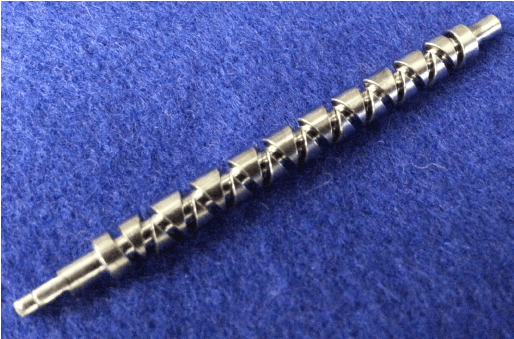
Injection molding is a manufacturing process that can form many products. One product that is commonly produced by the injection molding process is screws. It has been discovered, however, that using a reciprocating screw (a screw with lobed flights and lands) in the injection molding machine instead of a traditional injection molding screw provides certain benefits to manufacturers and consumers alike.
Less Waste
One of the most notable benefits offered by the reciprocating screw is its ability to produce screws with almost no wasted material, which lowers costs for manufacturers and consumers alike.
While traditional injection molding screws leave a thin film of plastic on the blades (to help eject the screw from the mold), they also shoot thin streams of molten plastic into the air while doing so. While these streams of plastic may be thin enough to just hang in the air, they also often drop back down on top of the screw and add more waste to the mix.
The reciprocating screw eliminates this issue, however, because it removes everything from its flights before ejecting itself from the mold. It does this by first retracting its flights and cutting off the flow of plastic (similar to a drill bit), and then it raises up slightly, ejecting all waste off of its blades. This leaves clean cutting edges at the end of every cycle, allowing for faster production speeds.
Reciprocating Screws vs Conveyor Screws
Reciprocating screws are often used as an alternative to a conveyor screw in injection molding machines. Conveyor screws have flights that push material forward after being melted, resulting in a thicker layer of plastic on top of the part being created.
Besides slowing down production speeds, this extra material must be cut off before ejecting from the mold. This can add significant time and cost at the end of each cycle. A reciprocating screw pushes the melt forward while oscillating, cutting off the excess material without slowing down speeds.
Reciprocating Screws vs Ram Screws
Ram screws are also commonly used in injection molding machines. These screws use a plunger that slides inside the barrel to push the plastic toward the nozzle. Ram screws are generally easier to maintain, but reciprocating screws are better for injection molding.
A reciprocating screw also has the same ability to compress or compact plastic as a ram screw. This can help decrease cycle time by forcing more plastic into each cavity. A ram screw does not have this extra compression capacity and must be replaced with a reciprocating screw if this function is needed.
Reciprocating Screws are more accurate than Ram Screws
The plunger on a ram screw rarely slides up and down the entire length of the barrel at one time, but an oscillating or reciprocating screw can move back and forth through its entire body without stopping. Because of this, a reciprocating screw is more accurate and can produce a better quality product than a ram screw from sliding to barrels, it covers everything.
Save time and money
Reciprocating screws can produce more parts per hour, with smaller injection molding machine sizes, which results in lower production costs. This also enables manufacturers to make cheaper machines that are less energy/gas consuming, and a better environmental solution for home decor and other activities.
More efficient use of space
Compared to ram screws, reciprocating screws often have a much smaller footprint because the barrel moves up and down, allowing for more barrel length in relation to screw diameter. This leaves less room for error in terms of part dimensions when it is time to assemble parts.
Higher quality products
Reciprocating screws are more accurate because the barrel only moves up and down, compared to ram screws that have a horizontal movement. Reciprocating screws can be programmed for extremely high repeatability because the screw length never changes during the injection molding process.
This is not possible with ram screws without changing the position of the screw shaft. This repeatability is important when molding tiny parts because it could cause them to be stuck in the barrel if there was any deviation from the programmed length.
Better surface quality
One benefit of moving up and down rather than back and forth is that reciprocating screws are better for injection molded plastic parts. The pressure on the screw always remains the same when it is moving up and down. When ram screws are used, the pressure fluctuates as they go back and forth during injection molding, which often leads to a lumpier surface on parts.
The point of injection can be adjusted more accurately because no barrel volume changes happen with reciprocating screws.
Conclusion
The result of all this is that parts are more consistent, the performance is better, and waste can be kept to a minimum. Of course, there are pros and cons to all the screws made for PIM, but clearly reciprocating screws are the best choice.
Natalie Chen
Related posts
Stay connected
- How LoveOn Chat Is Becoming the Most Versatile AI Companion for Digital UsersThe internet keeps shifting toward hyper-personal interaction, and AI companions are at the center of this shift. What used to be simple chatbots are now evolving into emotionally aware, adaptive, and multi-functional digital partners. Among the new generation of platforms, LoveOn Chat is becoming one... The post How LoveOn Chat Is Becoming the Most Versatile […]
